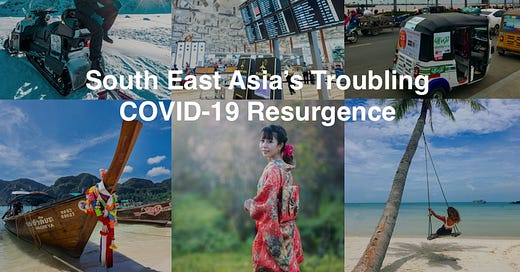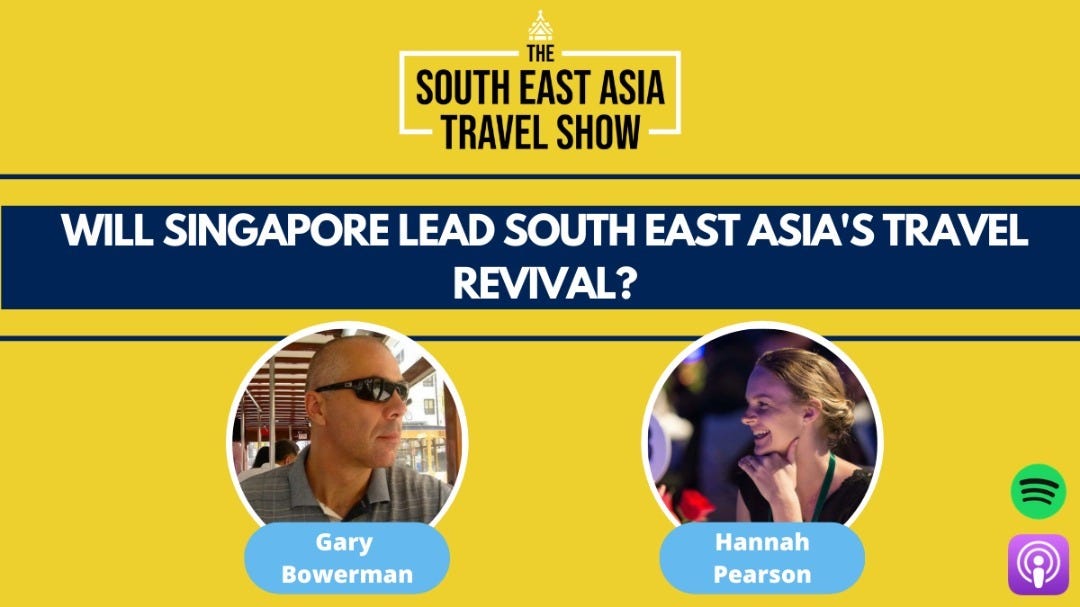Asia Travel Re:Set #37 - South East Asia's Troubling COVID-19 Resurgence
"It's increasingly hard to pinpoint where (and when) a travel recovery could emerge."
Hello. Welcome to Asia Travel Re:Set…
Eighteen days in a pandemic is a very long time.
South East Asia entered April with a tourism reopening planned in both Phuket and Bali, plus plentiful travel bubble speculation.
The landscape looks less positive now.
A resurgence of COVID-19 in parts of the region makes it harder to pinpoint where (and when) a genuine travel recovery could emerge.
While Bali is forging ahead, panic ripples through Phuket. Singapore and Hong Kong may reboot their postponed travel bubble, but bubble chat has quietened elsewhere.
Governmental caution is unlikely to change given the focus on COVID-19 statistics.
So let’s take a look at this month’s official numbers so far.
On 1 April, the 10 countries of South East Asia counted an accumulated 2,857,804 COVID-19 cases and 59,018 deaths.
The impact, though was disproportionately distributed.
Of the total cases, 53.10% were in Indonesia, and 26.46% in the Philippines, which together account for approx. 58% of ASEAN’s population. Some 69.56% of deaths were in Indonesia, and 22.54% in the Philippines. Malaysia accounted for 12.13% of cases, and 2.17% of deaths.
By 17 April, 3,151,508 accumulated cases and 63,920 deaths were recorded region-wide.
Worryingly, the number of active cases rose from 284,915 to more than 360,000.
On 1 April, 42.5% of active cases were in Indonesia, and 48.75% in the Philippines. By 17 April, active cases in the Philippines jumped from almost 139,000 to nearly 204,000.
Active case increases elsewhere in the region from 1-17 April are also concerning. These include Malaysia (14,399 to 20,464), Thailand (1,247 to 11,916) and Cambodia (1,219 to 3,316).
It feels like we’ve been here before. The story arc turns a familiar wheel. Waves recur, and strengthen.
That, I guess, is why it’s called a pandemic.
Thanks for being on board,
Gary
The Sunday Itinerary
- DashBoard
From 39.6 billion down to 23 in Asia Pacific this week.
- QuoteBoard
Maldives, Seychelles, Australia.
- South East Asia’s Troubling COVID-19 Resurgence
A snapshot round-up of a worrying month so far in ASEAN.
DashBoard
From 39.6 billion down to 23 in Asia Pacific this week…
USD39.6 billion: Value of Singapore-based Grab’s pre-Nasdaq IPO merger with Altimeter, whose founders are major investors in online travel. [Grab Official Statement]
40 million: The COVAX initiative has delivered 40 million COVID-19 vaccines to 110 countries “but it’s nowhere near enough,” says the WHO Director-General.
260,810: India continues to record an escalating daily COVID-19 infection total on 17 April, up 11.5% on the previous day. [Times of India]
60%: Percentage of SriLankan Airlines’ current monthly revenue attributed to cargo operations, CEO Vipula Gunatillika said this week on CAPA Live.
23%: Auckland Airport expects traffic to/from the city to rise 23% on Monday 19 April, day 1 of the Trans-Tasman Travel Bubble, compared to the previous week. [Press Release]
QuoteBoard
You heard it here…
“No negative PR test is required for tourists who visit Maldives two weeks (14 days) after their 2nd dose of a COVID-19 vaccine.”
Maldives Ministry of Tourism
“As the world around us shifts, we are entering a new era where work and vacation are blended into an experience where professionals and digital nomads can switch the mundane gloom of an office for an exotic island escape.”
Seychelles Tourism Board
“Consumers in China have become more engaged and consume more content directly through our channels as they seek to plan their trips when it is safe to do so.”
Tourism Australia
South East Asia’s Troubling COVID-19 Resurgence
A snapshot round-up of a worrying month so far in ASEAN…
Thailand
Let’s start in the Land of Smiles, where Wednesday registered 1,000+ daily COVID-19 cases for the first time since 5 February. The nation has since registered 3 consecutive days with more than 1,500 cases.
A chaotic and confusing Songkran holiday is winding up with an imminent surge of infections expected. Different provinces introduced specific entry, testing and quarantine rules for holidaymakers, but several island escapes saw strong arrivals.
Bangkok, meanwhile, is largely closed down. Along with 17 provinces, the capital faces two weeks of renewed restrictions from 18 April, including school, bar and tourism attraction closures and a ban on alcohol sales.
Meanwhile, panic is escalating in Phuket, which is scheduled to permit quarantine-free entry to vaccinated tourists from 1 July. Local media reports bookings being cancelled and postponed, and Bangkok Airways closed its ticketing offices in Bangkok, Chiang Mai and Phuket because “the situation is expected to intensify.” A decision on whether to defer the 1 July date will be taken this coming week.
Indonesia
Is Bali’s reopening to vaccinated travellers drifting? To be fair, unlike Phuket, Bali didn't initially set a concrete date. This week, Bloomberg and Bangkok Post, among others, predicted “by the end of July.” This is subject to completing vaccinations for 3 million residents in Ubud, Sanur and Nusa Dua - the selected visitor ‘green zones’.
The Bali Sun, meanwhile, noted that a government ban on domestic inbound/outbound travel to from Bali for the Eid-Al-Fitr holiday will see “the tourism sector in Bali fall into a deeper financial crisis.”
Meanwhile, the mega-merger between ride-hailing and lifestyle services app Gojek and e-commerce platform Tokopedia is ‘game-on’. A deal is being finalised to value the newly combined ‘Goto’ brand at around USD18 billion. An IPO seems likely in 2022.
Philippines
With a 7-day new case average of 10,500+, and over 11,000 cases on Saturday alone, the Philippines continues to struggle against the scope of viral spread. Active cases nudged above 200,000. This week, Business Mirror cited the UNWTO Travel Restrictions Report in an article titled Philippines among 69 places ‘closed’ by COVID-19:
“The Philippines has partial travel restrictions, as it allows the entry of returning overseas Filipinos, contract workers, and expatriates. However, it still prohibits the entry of foreign tourists and is thus, counted by UNWTO among the 69 destinations that have completely closed its borders to tourism.”
The entry ban on foreign arrivals - imposed on 22 March - has been pushed out to 30 April. It will likely be extended further. The government is ordering 20 million shots of Russia’s Sputnik V, plus 30 million doses of Novavax to assist its goal of inoculating 70 million people in 2021. Only 162,065 Filipinos had received two doses as of 13 April.
Despite its healthcare challenges, the Department of Tourism announced this week:
“The Philippine government is considering the use of the International Air Transport Association's (IATA) travel pass as part of the country's preparations for the resumption of international travel amid the pandemic.”
Singapore
Figures released this week show that just 18,200 visitors arrived under the Air Travel Pass scheme, which was introduced in phases from 21 August 2020. This includes 12,800 arrivals from China, 2,400 from Australia and 1,100 from Vietnam. The scheme is currently open to residents of Australia, Brunei, China, New Zealand and Taiwan, while an agreement with Vietnam is currently suspended.
Bad news for Singapore Airlines’ low-cost subsidiary Scoot, which incurred a 2-week ban on flights to Hong Kong, after two passengers tested positive for COVID-19 and another carried inadmissible documentation. This followed a similar temporary ban imposed by Hong Kong on Singapore Airlines, which ended on 17 April.
Despite this, the Hong Kong-Singapore Air Travel Bubble - which was postponed just before take-off in November - may be back on track. A revised agreement is “being finalised,” says Ong Ye Kung, Singapore’s Transport Minister. At Hong Kong’s behest, the bilateral bubble would require travellers to Singapore to be vaccinated. The SCMP is predicting “mid-May” for take off should Hong Kong fend off a new case surge.
Meanwhile, an austere editorial in The Straits Times, titled Pandemic a Long Way From Being Over, on Thursday surmised:
“While the desire to get out and to travel has grown, a resurgence of infections in Asia, including a recent new dormitory case in Singapore, should give everyone pause.”
Malaysia
Case numbers continued to head north this week Malaysia recorded 3 consecutive days of new infections exceeding 2,000 for the first time since 28 February.
The start of Ramadan on 13 April saw interstate travel remain off limits for people in most regions. Under current rules, the culmination of Ramadan - known locally as Hari Raya Aidilfitri - on 12 May will not be the usual popular period for travel to see family and friends, although this remains under government review.
The cost of the pandemic is cutting deeply into government finances. This week, Prime Minister Muhyiddin Yassin was quoted as saying:
“What I am trying to say here is, we don’t have much money left.”
Phase 2 of the vaccination programme commences on Monday 19 April, and Vaccine Minister Khairy Jamaluddin tweeted:
“We have procured enough Pfizer vaccine to cover 50% of our population. May increase to 70%. Sinovac covers 20%. Many who travel frequently to China have appealed for Sinovac.”
He also published a graphic, which - given the current level of vaccine registration and supply - shows when the availability of vaccines would outstrip jab demand.
Vietnam
As the vaccine-era travel lexicon expands almost daily, Vietnam should focus on “low-contact tourism,” according to a senior public health advisor. In particular, this would mean permitting entry to visitors from “countries and territories that have controlled the pandemic well and have massive vaccination programmes.”
The Health Ministry is lobbying to halve the mandatory quarantine period for vaccinated travellers to 7 days, from 14. This would be subject to a negative test result upon arrival and another after 6 days in quarantine.
Compulsory COVID-specific medical insurance is being recommended for inbound and outbound travellers, while Cambodia’s COVID-19 outbreak has southern Vietnam on edge is a media headline that would have been implausible just a couple of months ago.
On the brighter side, Bamboo Airways is readying for its IPO, which could raise up to USD200 million. Given current tech IPO valuations, that seems pretty small. The funds would be used to “expand our services globally,” the airline’s chairman, Trinh Van Quyet, told Reuters this week.
Cambodia
Cambodia’s tough response to its recent outbreak means stricter lockdown measures in Phnom Penh and Takhmao may extend beyond the 28 April expiry. Phnom Penh residents who visited their home province for Khmer New Year will be unable to return until restrictions are lifted.
By 16 April, 1.24 million people had received a vaccine. However, the Cambodian capital suspended its inoculation programme from 17-20 April due to “due to inability of medical personnel to get to work.”
Conversely, the government is “studying tour package” options for vaccinated inbound travellers, according to the Khmer Times. The travel benefits of being vaccinated could include permission to visit the temple ruins of Angkor Wat. This may not occur until the 4th quarter of 2021, however.
On this week's The South East Asia Travel Show, we talk all things travel & tourism in Singapore. Throughout the 2010s, the city state punched above its weight by thinking ahead and investing big.
What happens next as Singapore moves to reopen its travel economy? Which markets might bring back leisure and business travellers - and will the Singapore-Hong Kong air travel bubble succeed second time around?
And, that’s a wrap for Issue 37.
Next week, Dr Jaeyeon Choe and Michelle Dy will return for the April edition of our monthly Asia Pacific Travel & Tourism Report
Until then, catch me on Twitter, LinkedIn and the Asia Travel Re:Set website.
And feel free to send comments and feedback to gary@check-in.asia
Have a great week,
Gary






